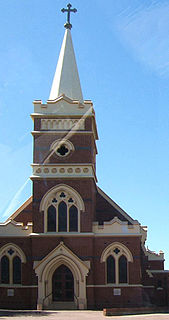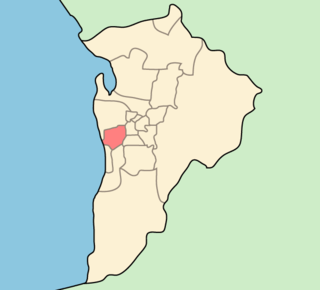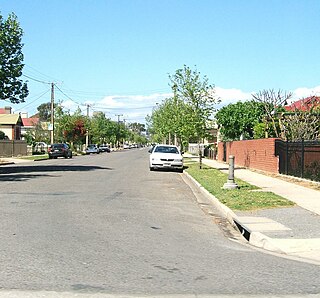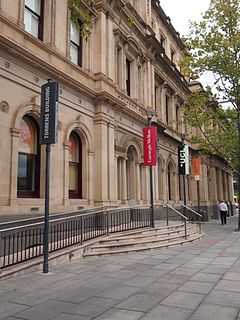
The University of Adelaide is a public university located in Adelaide, South Australia. Established in 1874, it is the third-oldest university in Australia. The university's main campus is located on North Terrace in the Adelaide city centre, adjacent to the Art Gallery of South Australia, the South Australian Museum and the State Library of South Australia.

The City of Port Adelaide Enfield, located across inner north and north-western suburbs of Adelaide, is one of the largest metropolitan councils within South Australia. It was established on 26 March 1996 by the amalgamation of the City of Port Adelaide and the City of Enfield.

Victoria Square, also known as Tarntanyangga, is the central square of five public squares in the Adelaide city centre, South Australia.

North Terrace is one of the four terraces that bound the central business and residential district of Adelaide, the capital city of South Australia. It runs east–west, along the northern edge of "the square mile". The western end continues on to Port Road, and the eastern end continues across the Adelaide Parklands as Botanic Road.

The Adelaide Park Lands are the figure-eight of land spanning both banks of the River Torrens between Hackney and Thebarton and separating the City of Adelaide from the surrounding suburbia of greater Metropolitan Adelaide, the capital city of South Australia. They were laid out by Colonel William Light in his design for the city, and originally consisted of 2,300 acres (930 ha) "exclusive of 32 acres (13 ha) for a public cemetery". One copy of Light's plan shows areas for a cemetery and a Post and Telegraph Store on West Tce, a small Government Domain and Barracks on the central part of North Tce, a hospital on East Tce, a Botanical Garden on the River Torrens west of North Adelaide, and a school and a storehouse southwest of North Adelaide.

Trinity City, is an Australian evangelical Anglican church located at 88 North Terrace in the city of Adelaide, South Australia. Trinity City has four gatherings at the North Terrace location each Sunday, as well as various other meetings throughout the week.

Torrensville is a suburb on Kaurna land two kilometres west of the centre of Adelaide, South Australia. It was named after Irish-born economist and chairman of the South Australian Colonisation Commission, Robert Torrens.

Hackney is an inner-eastern suburb of Adelaide, South Australia, in the City of Norwood Payneham St Peters. It is adjacent to the Adelaide Park Lands, the Adelaide city centre and North Adelaide. The O-Bahn Busway passes along Hackney Road, part of the City Ring Route, Adelaide, which forms its western boundary. Its other boundaries are the River Torrens (north), the continuation of North Terrace through Kent Town (south), and a series of small streets and lanes to the east.

Thebarton, formerly Theberton, on Kaurna land, is an inner-western suburb of Adelaide, South Australia in the City of West Torrens. The suburb is bounded by the River Torrens to the north, Port Road and Bonython Park to the east, Kintore Street to the south, and South Road to the west.

The City of West Torrens is a local government area in the western suburbs of Adelaide, South Australia. Since the 1970s the area was mainly home to many open spaces and parks, however after the mid-1990s (1993-1995) the LGA became more residential.

Government House, located in Adelaide on the corner of North Terrace and King William Road, is the official residence of the Governor of South Australia.

Fulham is a western suburb of Adelaide, South Australia. It is located in the City of West Torrens.

Hilton, on Kaurna land, is an inner western suburb of Adelaide, South Australia. It is located in the City of West Torrens, for which it is the council seat.

Mile End, on Kaurna land, is an inner western suburb of Adelaide, located in the City of West Torrens, around 2 kilometres from the Adelaide city centre. It has a census area population of 4,413 people (2011). Much of the suburb is residential, but there are small commercial areas along Henley Beach Road and South Road.

Adelaide city centre is the inner city locality of Greater Adelaide, the capital city of South Australia. It is known by locals simply as "The City" or "Town" to distinguish it from Greater Adelaide and from the City of Adelaide local government area. Due to the construction of many new apartments in the city, the population has grown over ten years from 10,229 to 15,115.
The South Australian Research and Development Institute (SARDI) is the principal research institute of the Government of South Australia, with a network of research centres, laboratories and field sites both in metropolitan Adelaide and throughout South Australia. SARDI is part of Primary Industries and Regions SA.

Park 12, is one of the 29 Parks that make up the Adelaide Park Lands. It consists of 55.5 hectares bounded by North Terrace, Frome Road, Sir Edwin Smith Avenue and King William Road

Torrens University is a private university in Australia. It is part of the Laureate International Universities network with campuses in Adelaide, Sydney, Melbourne and Brisbane. Upon commission, Torrens University became the 33rd university in Australia and the first new university for 20 years. It opened in 2013 and started teaching in 2014 in its headquarters building in the Torrens Building in Adelaide city centre. Admission is through Universities Admissions Centre and South Australian Tertiary Admissions Centre based on Australian Tertiary Admission Rank (ATAR).

Ashford House, located in the Adelaide suburb of Ashford, South Australia, was originally built in 1838 by Dr Charles Everard, and is amongst the oldest historic buildings in South Australia.
Lot Fourteen is a development site in the Australian state of South Australia which accommodated the old Royal Adelaide Hospital (RAH) at the eastern end of North Terrace, Adelaide and which became vacant after the hospital function was moved to a new building at the western end of North Terrace in 2017. Its name was derived from the original 1837 plan for Adelaide by surveyor-general Colonel William Light. As of December 2020, refurbished hospital buildings are already home to a large number of tenants, and further new buildings and public spaces are planned, scheduled for completion around 2025.






















